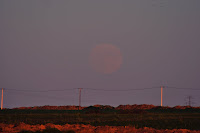I went out on July 24, 2010 with my good friend Bob of Blackholes and astrostuff fame. We were on time and set up and ready to go, but where the heck was the Moon? Our Moon phase info was accurate and we knew it was up, but what in the world was going on? It turns out that for one, there was a lot of forest-fire smoke in the sky above the horizon where we were looking for the Moon. The next problem is that we were out in our calculation of where it would be rising. So, by the time we noticed it, it had risen a couple of Moon widths from the horizon. No worries though, all turned out well and we were able to catch some decent shots.
The next night, July 25, 2010, we were both out at separate locations shooting the Moon again. It was cloudy in the area it was rising, but alas, the clouds dissipated and the Moon was out in full force. It was huge to say the least and looked amazing. I wish I had my telescope with me that night to take some Moon pictures through that, but I didn't. No problem. I managed to get some shots I was very happy with. Below are photos from both evenings. All were shot using a tripod-mounted Nikon D90 with a 70-300mm f/4-5.6 lens and a 1.5x teleconverter, with a remote shutter release. Enjoy.



























































